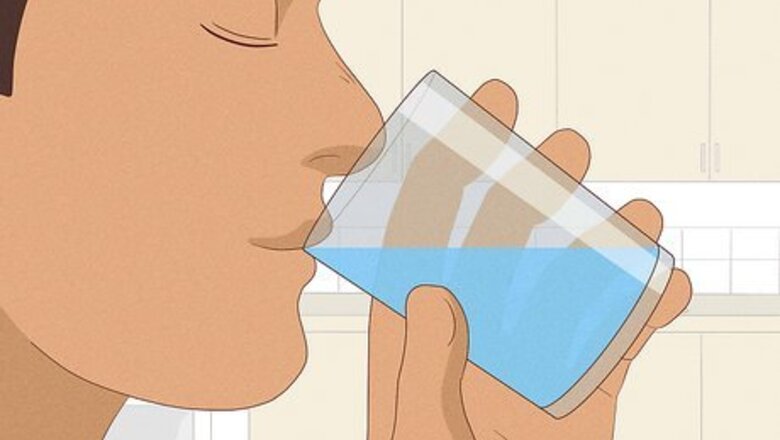
views
X
Trustworthy Source
Cleveland Clinic
Educational website from one of the world's leading hospitals
Go to source
While we’ve put together a few tips to help you shed some weight in the short term, we’ve also provided plenty of long-term diet suggestions, fitness plans, and lifestyle changes to help you reach sustainable, long-lasting results on your weight loss journey.
- Lose extra water weight by drinking 11.5 to 15.5 cups (2.7-3.7 L) of water each day. Eating low-sodium and potassium-rich snacks can also be a big help.
- Lose weight consistently by following a calorie-deficit diet—this is when you burn more calories than you intake within a day.
- Eat a diet that’s rich in whole grains, lean protein, and fresh fruits and veggies, and aim to get 150 minutes of exercise each week.
Water Weight Loss
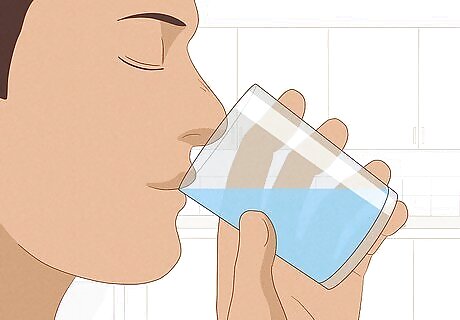
Drink 11.5 to 15.5 cups (2.7-3.7 L) of water each day. If you’re male, aim to drink 15.5 cups (3.7 L) of water each day; if you’re female, shoot for 11.5 cups (2.7 L). Believe it or not, your body needs water to lose water weight. Whenever you get dehydrated, your body holds onto the extra water in your system, which contributes to more water weight. When you stay hydrated, your kidneys have an easier time managing the amount of water and sodium that’s in your system. Take a refillable water bottle with you whenever you head out so you can stay hydrated wherever you go. Not sure how much water you’re drinking each day? Use a smartphone app like Water Balance (iOS/Android) or Water Reminder (iOS/Android) to track your hydration.
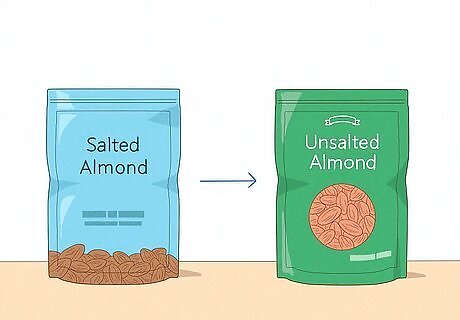
Snack on unsalted nuts and veggies instead of foods that are high in salt. Is your stomach growling but it’s not quite mealtime yet? Reach for some unsalted seeds or nuts to help satiate your hunger, rather than snacking on something extra salty. High sodium (salt) levels in your body make your body retain more water, which leads to more water weight. Here are a few other low-sodium snacks you might enjoy: Unsalted pretzels Unsalted popcorn Chips that are low in salt (less than 5% Daily Value of sodium)
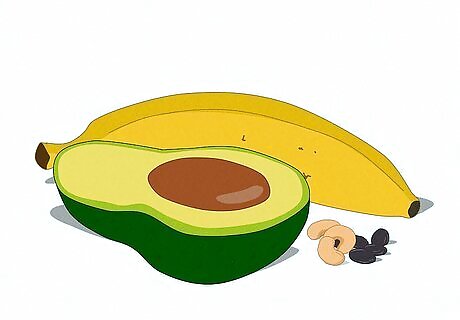
Stock up on potassium-rich foods to help lower your water weight. In the mood for a snack? Grab some raisins, bananas, avocados, cashews, and a variety of other foods that contain potassium. Potassium helps keep your body’s water and sodium levels in check, which helps with water weight management overall.
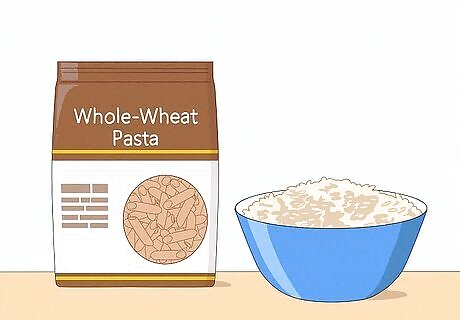
Cut back on carbs a little so your body holds onto less water. When kept in your muscles, carbs turn into glycogen (stored carbs), which often retain more water. This doesn’t mean you have to cut out carbs altogether, though—stock up on whole grains, like brown rice and whole-wheat pasta. Supplementing your diet with plenty of non-starchy veggies (like leafy greens) and protein can be a big help, too. On a low-carb diet, your average meal needs to be 50% veggies (the non-starchy kind), 25% protein, and 25% whole grains. Try to load up on lean proteins, which have less fat and calories. Extra lean ground beef, turkey, chicken, tuna, beans, lentils, fish, and shellfish are all great options.
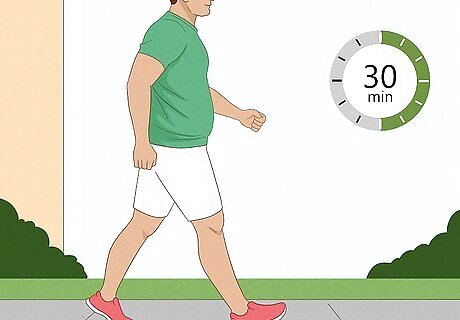
Work out for at least 30 minutes each day. As a general rule of thumb, it’s good to get your blood pumping each day, whether that’s going for a walk, hiking on a local trail, or playing a game of pick-up basketball with some friends. When you stay active, the physical activity helps you sweat and helps prevent water from collecting in the lower sections of your body. This—you guessed it—can help you lower your water weight overall.
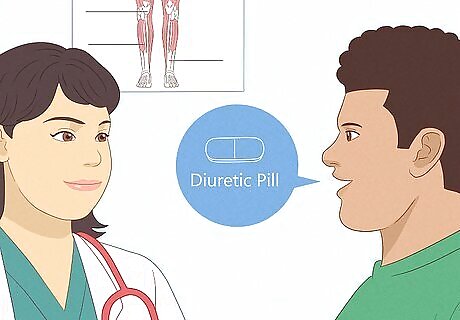
Talk to your doctor and see if diuretic pills are an option. Tell your doctor about your weight-loss goals, as well as your desire to try diuretic pills (also known as water pills). They can help you decide if this medication is a safe and healthy option for your weight-loss journey. Chat with your doctor about any other diuretic treatments you’re thinking about trying, like sauna visits or herbal supplements.
Diet Adjustments

Lose weight consistently with a calorie-deficit diet. Calculate your daily calorie needs and subtract 500 calories—expect to lose 0.5 kg (1 lb) each week by following that daily calorie goal. From a health perspective, burning more calories than you intake is the simplest way to lose weight. While it may be tempting to try a huge calorie deficit for major weight loss, medical professionals advise against this approach. Attempting a bigger deficit can lead to pretty unpleasant side effects (like tiredness, nausea, and constipation); plus, it’s harder to follow through with it in the long-term.
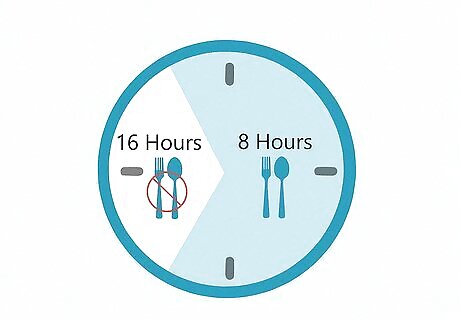
Try an intermittent fasting plan throughout the week. Choose an 8-hour period of the day where you’ll eat all of your daily calories, and a 16-hour period where you’ll fast. An example of this could be eating brunch at 11 AM and then eating dinner by 7 PM. Only calorie-free drinks (like water or unsweetened tea) are allowed during your fasting periods. Other intermittent fasting frameworks include the “5:2” plan, where you eat normally (without fasting) for 5 days of the week, and then eat nothing (fast) for the other two days. You could also try alternate-day fasting, which involves switching between a normal day of eating and a fast (or calorie-restricted day of eating).
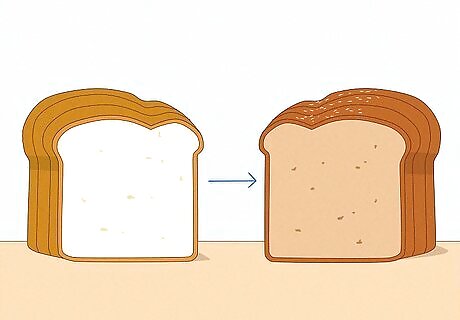
Upgrade at least 50% of your grains to be whole grains. Whole grains are rich in a lot of nutrients, including fiber, which helps you feel full after a meal. If refined grains (the opposite of whole grains) are a big part of your current diet, ease your way into whole grain territory with some simple substitutions, like whole-grain bread instead of white bread, or brown rice instead of white rice. Six servings of grains is the recommended daily portion for the average portion. A slice of bread or tortilla counts as 1 serving of grains, as well as a single portion of cereal or ⅛ cup (28 g) of pasta.
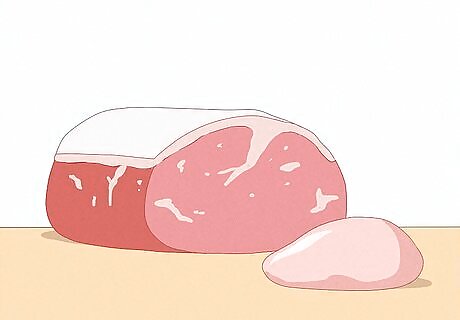
Eat enough protein to make up 10-35% of your daily calories. Let’s say that your daily calorie goal is 1,700 calories; using this guideline, eat anywhere from 170 to 595 calories worth of lean protein each day. Protein is an essential part of building your muscles—plus, it helps you feel satiated for longer, which can help with your weight-loss goals. Focus on leaner sources of protein—they’re lower in calories which can help support weight loss. Pork loin, skinless chicken breasts, and lean ground beef are all tasty lean protein options to consider. Still not totally sure how much protein you should be eating? Check the USDA’s Dietary Reference Intakes (DRIs) Calculator for extra assistance.
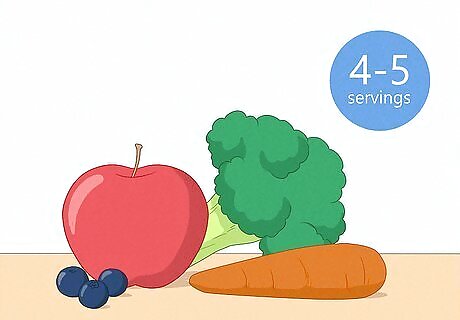
Munch on 4-5 servings of both fruits and veggies each day. Fresh, frozen, and canned produce all great ways to eat your fruits and veggies—just make sure that you’re eating at least 4 servings of fruit each day and 5 servings of veggies. Fruits and veggies are nutrient-rich, low in calories, and high in fiber, making them absolute superstars in a weight loss-friendly diet. A standard serving size of veggies is around 1 cup of leafy greens, ⁄2 c (120 mL) of veggie juice, and ½ cup of canned, fresh, or frozen veggies. A typical fruit serving size is ½ cup of canned, fresh or frozen fruit, ⁄4 c (59 mL) of fruit juice, or ¼ cup of dried fruit. A serving of whole fruit roughly equals the size of a clenched fist.
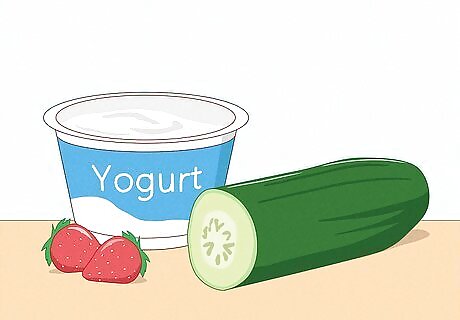
Eat healthy snacks if you get hungry throughout the day. Refined carbs and sweets won’t satisfy you in the long term, and just end up being empty and unnecessary calories. Instead, reach for a nutritious snack—fruit, veggies, whole grains, and yogurt are all fair game. Always try to eat intentionally. Rather than snacking while binging a show on Netflix, snack when your mind is clear and able to focus on what you’re eating.
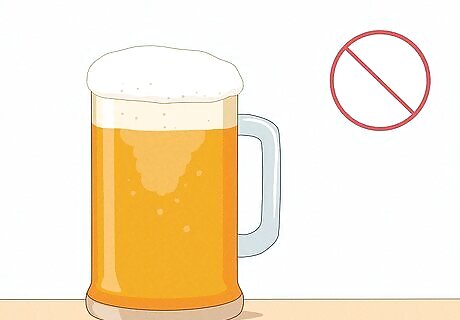
Cut out alcohol to help you lose weight. Alcohol has its fair share of calories. Considering that most people drink more than one serving of alcohol at a time, these calories add up quickly. Cutting out drinks may help you slim down faster and stick to your goals. Eliminating alcohol from your diet may also help you sleep better and have more energy overall.

Limit your caffeine consumption to potentially prevent weight gain. If you have the option, grab a low-caffeine or caffeine-free drink as a pick-me-up. Caffeine hikes up cortisol, a stress hormone, which may snowball into habits like emotional eating. High caffeine levels can also lead to low blood sugar, which can also make you tempted to munch on higher-calorie snacks. When you drink tea or coffee, don't add sugar or other sweeteners. This is an easy way to cut calories!

Limit yourself to healthy snacks if you decide to eat before bed. If you’re feeling a little hungry in the late hours of the night, reach for a nutritious snack that’s full of protein and/or whole grains, like a bowl of whole-grain cereal. Cutting out nighttime snacking may help you cut back on calories, especially if you tend to eat a lot of snacks at night. While eating late in the day has no effect on your metabolism or how your body uses calories, nighttime can be a prime time for mindless eating.
Regular Exercise
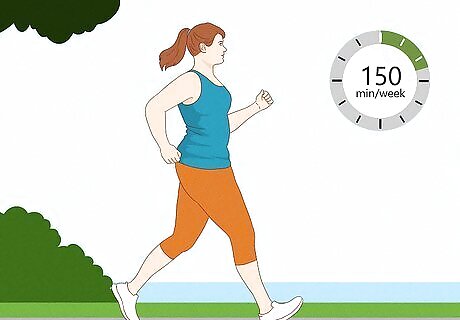
Participate in 150 minutes of moderate-level cardio each week. Medical experts suggest getting around 150 minutes of “moderate-intensity aerobic activity” each week—in other words, a power-walk around the neighborhood or something similar. Try to spread your exercise sessions out over 5 days of the week, dedicating 30 minutes to each workout. This exercise plan is great if you have a small window of time to exercise each day.
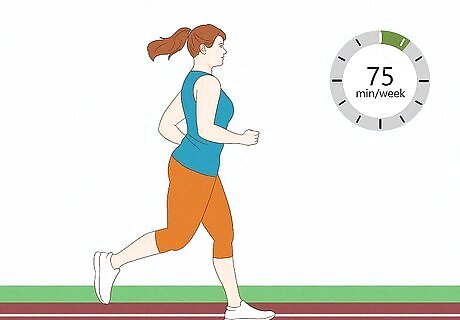
Do 75 weekly minutes of high-intensity cardio if you’re pressed for time. Not sure if the 150-minute weekly workout schedule is for you? Try doing “vigorous-intensity aerobic activity” for 75 total minutes throughout the week, like going for a jog. This type of workout schedule might be best if you only have the weekends free to exercise. You might jog for 35 minutes on Saturday, and then go for a 40-minute swim on Sunday. Try short HIIT (High Intensity Interval Training) workouts as part of your vigorous exercise regimen. During HIIT training, alternate between going all-out for around 20 seconds, and then giving yourself 10 seconds to rest. Repeat this cycle for 4 minutes, and then give yourself another 1-minute break. Do this cycle 3 more times to finish up your HIIT workout for the day.
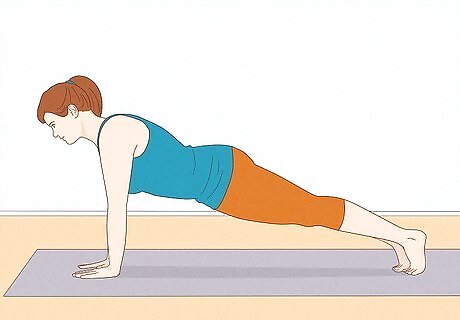
Perform strength-training exercises twice a week. Focus on exercises that target different parts of your body, including your shoulder, legs, hips, back, chest, abdomen, and arms. Aim to do at least one 8-12 rep set for each muscle group. Not sure how to get started? Check out some of wikiHow’s fitness resources here: Leg workouts Shoulder workouts Chest workouts Back workouts Abdomen workouts Arm workouts
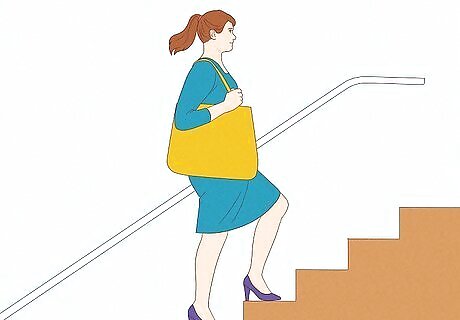
Amp up your activity levels throughout the day. Take your dog out for a loop around the neighborhood, or walk in place while you get caught up on your favorite TV show. Simple additions (or substitutions) to your daily routines are great opportunities to add a little more fitness to your life. Here are a few more ideas: Walk to a nearby store instead of driving there Climb up the stairs rather than taking the elevator Invite a friend or loved one to go for a walk with you
Lifestyle Factors

Sleep 7-9 hours each night. Try to go to bed earlier and sleep in later if possible. It also helps to reduce devices that make sound or light to help ensure you get a sound sleep. A lack of sleep can trigger your body to release higher levels of hormones that cause you to feel hungry—in fact, those who are sleep deprived typically crave higher fat foods. Try to make your bedroom as comfortable as possible by setting the temperature to 65 to 69 °F (18 to 21 °C) and hanging up darkening shades. Heading to bed a little earlier can help you cut down on any late-night snacking.
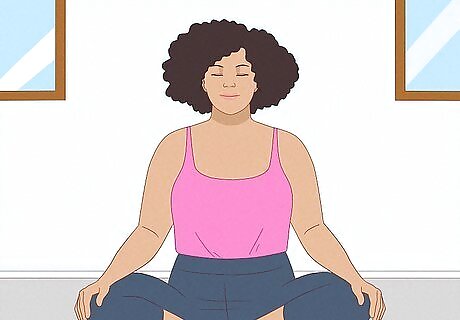
Prioritize relaxation and stress management in your day-to-day routine. Stress is no joke—not only does it make you hungrier, but it makes you crave less-than-healthy foods and snacks. Tackle your stress head-on by exercising regularly, meditating, and spending time with friends and loved ones. Journaling, creative hobbies, and yoga are other great ways to de-stress and add some relaxation to your life. Think about seeing a life coach or licensed therapist if stress is something that's difficult to manage in your life.
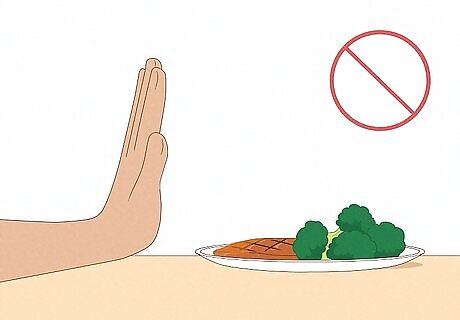
Refrain from skipping meals. You’d think that skipping meals would be an easy way to shed a few kilograms/pounds, but it actually has the opposite effect. Whenever you skip a meal, your body’s metabolism lowers and you end up burning fewer calories. Plus, skipping meals leaves you feel exhausted, icky, and definitely less than your best.










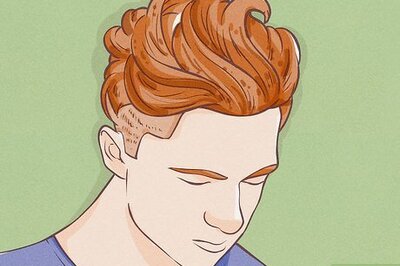





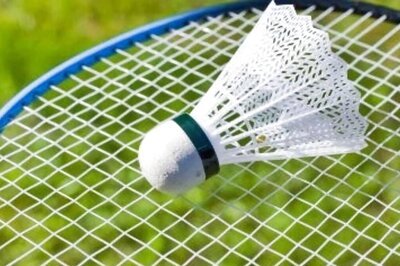

Comments
0 comment